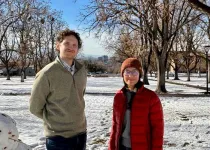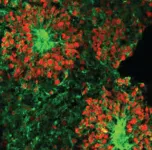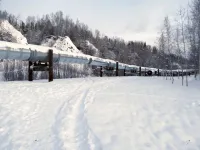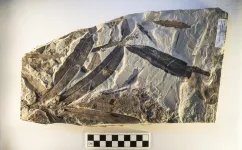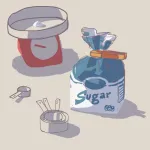(Press-News.org) It’s well established that urban tree cover provides numerous environmental and psychological benefits to city dwellers. Urban trees may also bolster education outcomes and their loss could disproportionately affect students from low-income families, according to new research by University of Utah social scientists.
Economics professor Alberto Garcia looked at changes in school attendance and standardized test scores at schools in the Chicago metropolitan region over the decade after a non-native beetle called the emerald ash borer appeared in North America, eventually killing millions of ash trees along the streets and yards of Midwestern cities. His results are both alarming and insightful, revealing a complex interplay between environmental degradation and social inequities.
Linking tree loss to education
The study analyzes how the loss of tree cover influenced education outcomes in the Chicago metropolitan region, which was hit hard by the infestation. Ash had been the region’s most common non-invasive tree species, accounting for 18% of its street trees, or about 85,000 trees. Between 2010 and 2020 Chicago lost half its standing ash, with the remaining half already dead or in decline, according to the Morton Arboretum.
The study tracked changes in student performance on a standardized test administered to 3rd- through 8th-graders in Illinois, from 2003 to 2012.
“We found that test scores in areas with ash borer infestations were reduced after the onset of those infestations relative to unaffected areas that were similar,” Garcia said.
“We also looked at heterogeneity in the income distribution, and we found that schools with more low-income students were less likely to experience infestations. These neighborhoods have less tree cover, so there is less likelihood that ash borer is going to establish,” he continued. “We don't think that the low-income students in unaffected areas are impacted, but the low-income students at these impacted schools seem to be affected more than better-off students at these same schools.”
The results were reported this month in the journal Global Environmental Change. The study was co-authored by ecologist Michelle Lee, who recently joined the School of Environment, Society & Sustainability as a professor in the Utah’s College of Social & Behavioral Science after completing a postdoctoral fellowship at Penn State.
Prior research shows students in neighborhoods with greater tree cover see better test scores. A recent study by U sociologists and geographers, for example, demonstrated how low-income Utah neighborhoods have less tree canopy near their schools. Meanwhile, schools with greater tree cover had fewer students testing below proficient on year-end math and language arts exams.
Generally speaking, better education outcomes could simply be a function of these leafy neighborhoods’ higher incomes, Garcia noted.
“Our study is trying to come a little closer to establishing a causal link,” Garcia said. “We used this natural experiment of the emerald ash borer beetle being introduced and then idiosyncratically spreading around the different neighborhoods in the Chicago metropolitan area.”
To conduct the study, Garcia and Lee built a novel dataset, combining satellite imagery with Illinois’ standardized testing data and emerald ash borer survey efforts.
“We got kind of lucky that the state of Illinois was administering this standardized test in that same window when the ash borer first arrived in the area,” Garcia explained. “Every school in Illinois was taking the same test, so we had consistent data across schools and through time.”
Disparate impacts on students
Instead of merely reaffirming the tree cover-test score correlation, Garcia and Lee were able to track changes in school attendance and scores on standardized tests as the beetle infestation ran its course, laying waste to Chicago’s ash trees over the span of a decade.
The study identified a 1.22% reduction in the number of students meeting or exceeding Illinois' standardized testing benchmarks in areas hit by the ash borer. This seemingly modest drop carries significant implications when scaled across the entire student population.
“We found that schools with more low-income students were less likely to experience infestations because these neighborhoods have less tree cover,” Garcia noted. “But the low-income students at wealthier schools, where infestations were more common, seemed to bear the brunt of the impacts.”
Speculating on the mechanisms driving these effects, Garcia noted loss of tree cover could exacerbate urban heat islands, increase air pollution, and diminish the psychological and physiological benefits that greenery provides.
“Some possible explanations are just that those students don't have the same resources to go home and recover from, for example, extreme temperatures or pollution-induced headaches the same way that higher-income students at the same schools might have,” Garcia said.
Low-income students may also spend more time outdoors in their neighborhoods or remain longer near the school, increasing their exposure to degraded environmental conditions. Conversely, wealthier students might commute from more distant areas or have access to climate-controlled environments that mitigate these impacts.
Environmental justice implications
The findings highlight how environmental changes disproportionately affect vulnerable populations. While low-income neighborhoods were less likely to lose tree cover, low-income students—particularly those attending wealthier schools—suffered setbacks when infestations occurred.
“It’s not just about access to environmental amenities,” Garcia said. “It’s about understanding how their absence can create inequities that ripple through critical aspects of life, like education.”
The study underscores the importance of urban forestry initiatives and invasive species management. Efforts to maintain and restore tree cover could play a vital role in mitigating environmental and social disparities. Garcia’s work also opens the door for further exploration into how ecosystem changes shape human outcomes, particularly in urban settings where environmental inequities are stark.
The study, “Unequally distributed education impacts of ecosystem degradation: Evidence from an invasive species,” appears in the December 2024 edition of Global Environmental Change.
END
How loss of urban trees affects education outcomes
Economics study highlights how ecosystem degradation disproportionately impacts disadvantaged communities
2024-12-17
ELSE PRESS RELEASES FROM THIS DATE:
New virtual reality-tested system shows promise in aiding navigation of people with blindness or low vision
2024-12-17
A new study offers hope for people who are blind or have low vision (pBLV) through an innovative navigation system that was tested using virtual reality. The system, which combines vibrational and sound feedback, aims to help users navigate complex real-world environments more safely and effectively.
The research from NYU Tandon School of Engineering, published in JMIR Rehabilitation and Assistive Technology, advances work from John-Ross Rizzo, Maurizio Porfiri and colleagues toward developing a first-of-its-kind ...
Brain cells remain healthy after a month on the International Space Station, but mature faster than brain cells on Earth
2024-12-17
LA JOLLA, CA—Microgravity is known to alter the muscles, bones, the immune system and cognition, but little is known about its specific impact on the brain. To discover how brain cells respond to microgravity, Scripps Research scientists, in collaboration with the New York Stem Cell Foundation, sent tiny clumps of stem-cell derived brain cells called “organoids” to the International Space Station (ISS).
Surprisingly, the organoids were still healthy when they returned from orbit a month later, but the cells had matured faster compared ...
NIH grant funds study of cerebral small vessel disease
2024-12-17
Researchers at Washington University School of Medicine in St. Louis have been awarded $7.5 million from the National Institutes of Health (NIH) to investigate a form of dementia caused by cerebral small vessel disease, the second-leading cause of dementia after Alzheimer’s disease.
The grant funds the Vascular Contributions to Cognitive Impairment and Dementia (VCID) Center, which is a National Institute of Neurological Disorders and Stroke “Center Without Walls” initiative that will coordinate researchers at six sites across ...
Paranoia may be, in part, a visual problem
2024-12-17
New Haven, Conn. — Could complex beliefs like paranoia have roots in something as basic as vision? A new Yale study finds evidence that they might.
When completing a visual perception task, in which participants had to identify whether one moving dot was chasing another moving dot, those with greater tendencies toward paranoid thinking (believing others intend them harm) and teleological thinking (ascribing excessive meaning and purpose to events) performed worse than their counterparts, the study found. Those individuals more often — and confidently — claimed one dot was chasing the other when it wasn’t.
The findings, published Dec. 17 in ...
The high cost of carbon
2024-12-17
The social cost of carbon — an important figure that global policymakers use to analyze the benefits of climate and energy policies — is too low, according to a study led by the University of California, Davis.
The study, published today in the journal Proceedings of the National Academy of Sciences (PNAS), shows that current estimates for the social cost of carbon, or SCC, fail to adequately represent important channels by which climate change could affect human welfare. When included, the SCC increases to just over $280 per ton of CO2 emitted in 2020 — more than double the ...
This mysterious plant fossil belongs to a family that no longer exists
2024-12-17
In 1969, fossilized leaves of the species Othniophyton elongatum — which translates to “alien plant” — were identified in eastern Utah. Initially, scientists theorized the extinct species may have belonged to the ginseng family (Araliaceae). However, a case once closed is now being revisited. New fossil specimens show that Othniophyton elongatum is even stranger than scientists first thought.
Steven Manchester, curator of paleobotany at the Florida Museum of Natural History, has studied 47-million-year-old fossils from Utah for several years. While visiting ...
Physicists ‘bootstrap’ validity of string theory
2024-12-17
String theory, conceptualized more than 50 years ago as a framework to explain the formation of matter, remains elusive as a “provable” phenomenon. But a team of physicists has now taken a significant step forward in validating string theory by using an innovative mathematical method that points to its “inevitability.”
String theory posits that the most basic building blocks of nature are not particles, but, rather, one-dimensional vibrating strings that move at different frequencies ...
Parents’ childhood predicts future financial support for children’s education
2024-12-17
UNIVERSITY PARK, Pa. — Childhood circumstances, such as parental divorce or growing up poor, have been shown to influence health and other outcomes later in life. But does a person’s experiences in childhood also influence their future ability to provide financial support to their children?
According to a new study from a researcher from Penn State, parents who endured difficult childhoods provided less financial support to their children’s education such as college tuition compared to parents who experienced few or no disadvantages. Regardless of current socioeconomic ...
SFU study sheds new light on what causes long-term disability after a stroke and offers new path toward possible treatment
2024-12-17
A recent study from Simon Fraser University researchers has revealed how an overlooked type of indirect brain damage contributes to ongoing disability after a stroke.
The paper, published in Proceedings of the National Academy of Sciences, shows how the thalamus – a sort of central networking hub that regulates functions such as language, memory, attention and movement – is affected months or years after a person has experienced a stroke, even though it was not directly damaged itself. The findings may lead to new therapies that could reduce the burden of chronic stroke, which remains one of the leading causes of disability in the world.
“Our ...
More calories – more consumption: Individuals with and without obesity both prefer high-calories food
2024-12-17
Higher calorie foods were preferred among individuals with and without obesity despite similar taste and texture, according to a study published December 17th in the open-access journal PLOS Biology by Albino Oliveira-Maia from the Champalimaud Foundation, Portugal, and colleagues.
Eating sends signals to the brain with information about a food’s energy content, which can influence food preferences irrespective of flavor. People with obesity often have impairments in areas of the brain where dopamine ...
LAST 30 PRESS RELEASES:
Understanding the role of linear ubiquitination in T-tubule biogenesis
Researchers identify urban atmosphere as primary reservoir of microplastics
World’s oldest arrow poison – 60,000-year-old traces reveal early advanced hunting techniques
Bristol scientists discover early sponges were soft
New study uncovers how rice viruses manipulate plant defenses to protect insect vectors
NSF–DOE Vera C. Rubin Observatory spots record-breaking asteroid in pre-survey observations
Ribosomal engineering creates “super-probiotic” bacteria
This self-powered eye tracker harnesses energy from blinking and is as comfortable as everyday glasses
Adverse prenatal exposures linked to higher rates of mental health issues, brain changes in adolescents
Restoring mitochondria shows promise for treating chronic nerve pain
Nature study identifies a molecular switch that controls transitions between single-celled and multicellular forms
USU chemists' CRISPR discovery could lead to single diagnostic test for COVID, flu, RSV
Early hominins from Morocco reveal an African lineage near the root of Homo sapiens
Small chimps, big risks: What chimps show us about our own behavior
We finally know how the most common types of planets are created
Thirty-year risk of cardiovascular disease among healthy women according to clinical thresholds of lipoprotein(a)
Yoga for opioid withdrawal and autonomic regulation
Gene therapy ‘switch’ may offer non-addictive pain relief
Study shows your genes determine how fast your DNA mutates with age
Common brain parasite can infect your immune cells. Here's why that's probably OK
International experts connect infections and aging through cellular senescence
An AI–DFT integrated framework accelerates materials discovery and design
Twist to reshape, shift to transform: Bilayer structure enables multifunctional imaging
CUNY Graduate Center and its academic partners awarded more than $1M by Google.org to advance statewide AI education through the Empire AI consortium
Mount Sinai Health system receives $8.5 million NIH grant renewal to advance research on long-term outcomes in children with congenital heart disease
Researchers develop treatment for advanced prostate cancer that could eliminate severe side effects
Keck Medicine of USC names Christian Pass chief financial officer
Inflatable fabric robotic arm picks apples
MD Anderson and SOPHiA GENETICS announce strategic collaboration to accelerate AI-driven precision oncology
Oil residues can travel over 5,000 miles on ocean debris, study finds
[Press-News.org] How loss of urban trees affects education outcomesEconomics study highlights how ecosystem degradation disproportionately impacts disadvantaged communities
